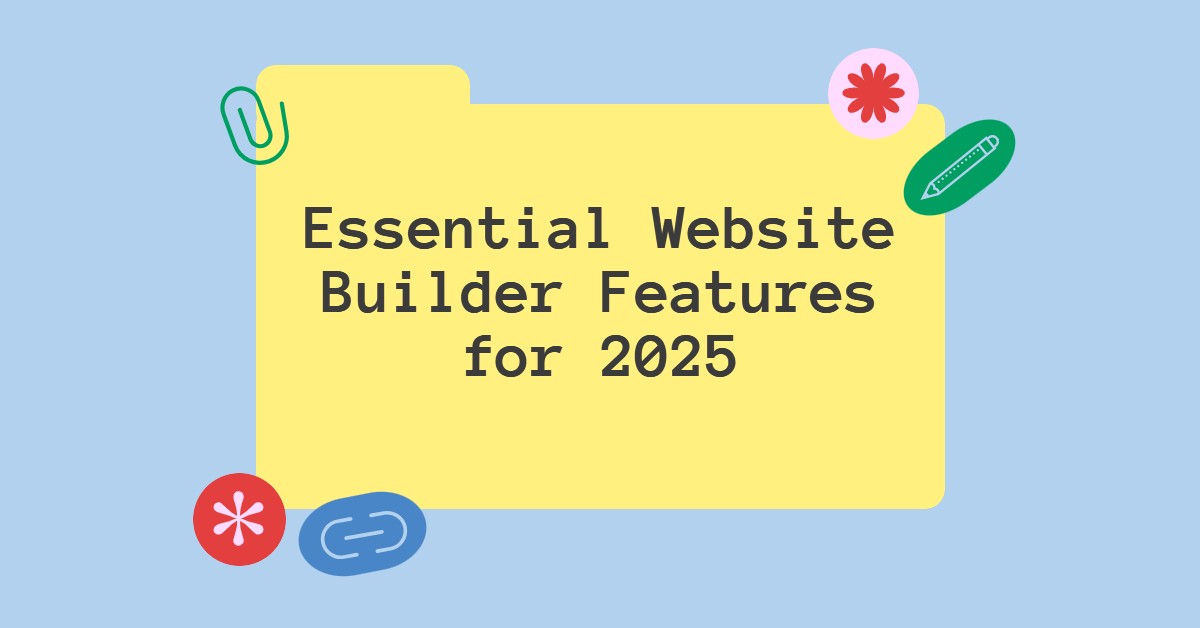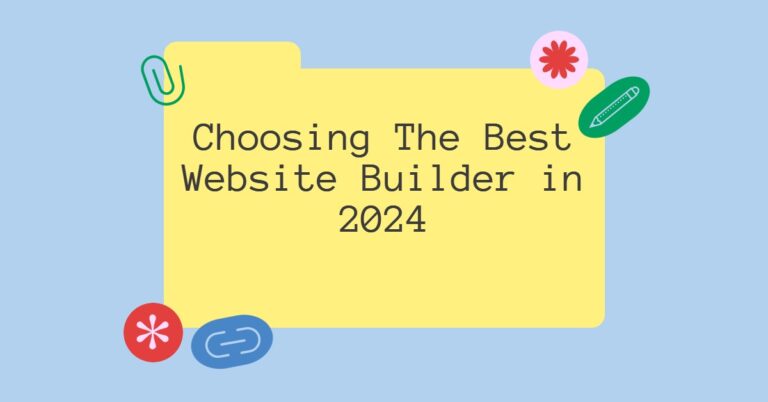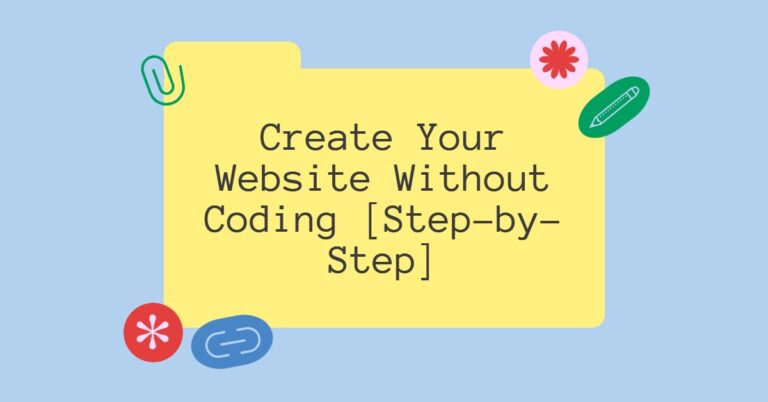Choose the Right Website Builder: Features That Truly Matter in 2025

If you’ve ever searched for a website builder, you’ve likely found yourself knee-deep in options. It’s like walking into an ice cream shop with a hundred flavors and realizing you only want one scoop. But which one? The choice feels overwhelming, doesn’t it?
The truth is, not all website builders are created equal. Some are perfect for small businesses, while others cater to bloggers or creatives. Picking the wrong one could mean wasted time, money, and frustration. But fear not—this guide is here to help you cut through the noise and find the website builder that fits your needs like a glove.
By the end of this article, you’ll know exactly what features to look for, how to align them with your goals, and how to avoid costly mistakes. So, grab your metaphorical ice cream cone, and let’s dig in.
Understand Your Goals Before Diving In
Let’s start with the basics: Why are you building a website in the first place? Knowing your end goal is like having a map before a road trip—it keeps you on track.
Define Your Purpose
Is your site for blogging, e-commerce, a portfolio, or just a personal space to showcase your ideas? Each purpose comes with its own set of requirements.
For instance:
- Bloggers need intuitive content management systems (CMS), strong SEO tools, and easy social media integration.
- Small business owners prioritize lead generation, payment processing, and customer engagement.
- E-commerce entrepreneurs must have robust inventory management and secure payment gateways.
Think About Growth
Sure, you might only need a small site now, but what about six months or a year down the road? A scalable website builder saves you from the nightmare of migrating platforms later.
Be Realistic About Your Budget
Your budget determines whether you’ll use a free website builder or pay for premium features. Many builders lure you in with a free plan but quickly lock essential tools behind a paywall. Know what you’re willing to spend upfront.
Key Takeaway
Start by defining your goals, anticipating growth, and setting a clear budget. This clarity narrows your options and keeps you focused.
Features That Matter in 2024: Tailored to Your Needs
Not all features are created equal. What matters to a small business owner might be irrelevant to a creative freelancer. Here’s a breakdown:
For Small Business Owners
- Lead Generation Integration: Capture potential customers with forms, chatbots, or email sign-ups. For example, a boutique fitness studio implemented a chatbot integrated with their website and email marketing platform. Within three months, they saw a 35% increase in email sign-ups as the chatbot guided visitors through a short, engaging quiz tailored to their fitness goals. This not only expanded their email list but also improved engagement rates as users felt the studio understood their needs.
- Payment Gateways: Even if you’re not an e-commerce business, tools like PayPal and Stripe integration can make invoicing smoother. For instance, a small consulting firm streamlined its invoicing process by integrating Stripe with their website builder. Before integration, they faced delays in collecting payments due to manual invoicing errors. After adopting Stripe, the firm reduced payment processing time by 40% and saw a 15% increase in on-time payments, boosting cash flow and client satisfaction. This improvement freed up resources, enabling them to take on 10% more projects annually, directly contributing to increased revenue.
Key Takeaway
Start by defining your goals, anticipating growth, and setting a clear budget. This clarity narrows your options and keeps you focused.
For Creatives and Freelancers
- Stunning Templates: Your website should reflect your creativity. Builders like Webflow allow unmatched customization. For instance, a graphic designer used Webflow’s advanced features to create a portfolio with dynamic animations and interactive elements. Unlike traditional drag-and-drop builders, Webflow provided full control over the design process, enabling the designer to stand out in a saturated market. This customization led to a 70% increase in client inquiries within three months, showcasing how tailored tools can elevate creative work.
- Portfolio Layouts: Have you ever walked into an art gallery where the paintings were crammed together, making it impossible to appreciate the beauty of each piece? That’s the problem many creatives face with cluttered or generic website layouts. It frustrates visitors, turning potential clients away. With Webflow’s customization features, you can design an elegant, intuitive portfolio that highlights your work like a curated exhibit. A freelance photographer shared how switching from a generic builder to Webflow increased her site engagement by 60% and directly landed her three high-value clients in the first month. Clean layouts don’t just showcase your work—they elevate your brand.
- Client Management Tools: Platforms like Duda include features for managing client relationships, especially if you offer services.
For E-Commerce Sites
- Secure Payment Gateways: From credit cards to digital wallets, your checkout process should feel seamless.
- Inventory Management: Shopify and BigCommerce excel in this arena, especially for larger inventories.
- Scalable Hosting: Ensure your platform can handle high traffic during sales or product launches.
For Bloggers
- Content Categorization: Make it easy for readers to find what they’re looking for.
- Social Media Sharing: Tools like WordPress’s Jetpack make social promotion a breeze.
- Monetization Options: Consider ad placement and affiliate marketing capabilities if revenue is part of your plan.
Key takeaway: Choose a builder that aligns with your specific use case, and don’t settle for features you’ll never use.
Cutting-Edge Features to Look for in 2024
The digital landscape is evolving, and website builders are stepping up their game. Here are some of the newest features worth considering:
1. AI-Driven Design Suggestions
Imagine having a virtual assistant that helps you choose the perfect layout, color scheme, and fonts based on your brand identity. Builders like Wix ADI (Artificial Design Intelligence) offer this feature.
2. Voice Search Optimization
With more people using voice assistants like Alexa and Siri, optimizing for voice search is no longer optional. Ensure your platform supports structured data and conversational content strategies.
3. Accessibility Tools
An accessible website isn’t just ethical; it’s smart. Features like screen reader compatibility and keyboard navigation make your site usable for all visitors, including those with disabilities.
4. Integrated Analytics
Knowledge is power. Built-in analytics tools help you track performance, understand user behavior, and make data-driven decisions without needing third-party integrations.
Key Takeaway
Staying ahead means leveraging cutting-edge tools that future-proof your site and keep it competitive.
Data-Driven Comparison of Popular Builders
Let’s compare some of the most popular website builders, focusing on what they do best.
| Platform | Best For | Notable Features | Price Range |
|---|---|---|---|
| Wix | Beginners and SMBs | Drag-and-drop, AI design, app integrations | Free – $45/month |
| Squarespace | Creatives and Portfolios | Stunning templates, built-in SEO | $16 – $54/month |
| Shopify | E-commerce | Robust inventory, scalable hosting | $29 – $299/month |
| Webflow | Advanced customization | Visual design freedom, CMS capabilities | Free – $212/month |
| WordPress.org | Bloggers and developers | Highly customizable, wide plugin library | Hosting costs vary |
Key Takeaway
Match your needs with the platform’s strengths. There’s no “one-size-fits-all” solution.
Actionable Tips for Choosing the Right Builder
1. Test the Waters with Free Trials
Most platforms offer free plans or trials. Take advantage of these to test functionality, design flexibility, and ease of use.
2. Focus on Scalability
Even if your site starts small, ensure the builder can grow with you. Moving platforms later is often expensive and time-consuming.
3. Check Support Options
Nothing is worse than running into a technical issue with no help in sight. Prioritize platforms offering 24/7 customer support.
4. Read Real User Reviews
Reviews can provide insights into a platform’s reliability and potential hidden pitfalls.
5. Keep SEO in Mind
Your website is only as good as its visibility. Opt for builders with built-in SEO tools and user-friendly analytics.
Key Takeaway
A methodical approach to testing and evaluating will save you headaches down the road.
Conclusion: Make the Right Choice Today
Choosing a website builder doesn’t have to feel like a daunting task. By understanding your goals, focusing on the features that matter most to you, and leveraging the latest tools, you’re already halfway there.
Remember, the perfect platform is the one that aligns with your unique needs—not necessarily the one with the most bells and whistles. So, take your time, do your homework, and start building a website that truly represents you or your brand.
Got questions or experiences to share? Drop them in the comments below. I’d love to hear from you!


